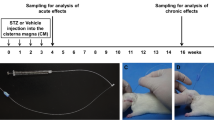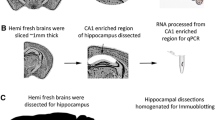Summary.
Sporadic Alzheimer’s disease (SAD), a progressive neurodegenerative disease, is the most common cause of dementia. The etiology of the disease is still unknown, but it is suspected to be a concert of genetic and environmental factors. Intracerebroventricular injection of streptozotocin (STZ), which inhibits insulin receptor function, develops long-term and progressive deficits in learning, memory and cognitive behavior as well as biochemical changes and neuronal degeneration in rats similar to SAD. Micro-array analysis provides a genome-wide, nonbiased study of gene expression patterns. The aim of this study was to investigate the gene expression pattern in the STZ animal model for SAD. RNA from rat cortex, striatum and cerebellum were analyzed for gene expression pattern via Affymetrix neurobiology chip-array and confirmed by real-time RT-PCR. Genes such as potassium channels, GABA receptors and glutamate transporter were up regulated, while insuline-like growth factor receptor was down regulated in STZ rats. These pathways may reveal molecular events causing the neuronal death in SAD.
Similar content being viewed by others
Author information
Authors and Affiliations
Rights and permissions
About this article
Cite this article
Grünblatt, E., Hoyer, S. & Riederer, P. Gene expression profile in streptozotocin rat model for sporadic Alzheimer’s disease. J Neural Transm 111, 367–386 (2004). https://doi.org/10.1007/s00702-003-0030-x
Received:
Accepted:
Published:
Issue Date:
DOI: https://doi.org/10.1007/s00702-003-0030-x




